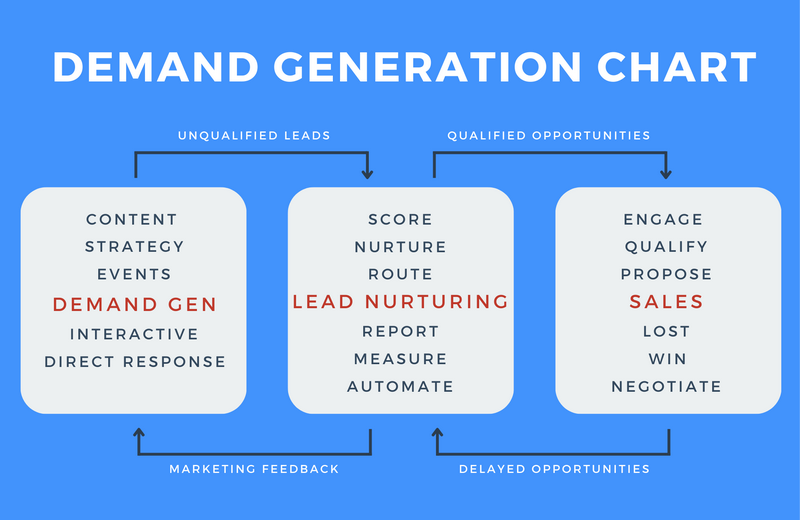Demand generation, as an expression, is very popular – but the concept evades many new marketers and start up managers who are just trying to sell their product.
In this quick guide, we’ll tell you what you need to know about demand generation, what it is, its main concepts, and how to ace demand generation marketing.
What Is Demand Generation?
Demand generation consists of a series of practices with the goal of generating knowledge and awareness about your brand. By creating product-market fit, you can make sure that your products will solve your customers’ issues. Basically, you need to get the right product/service, to the right people, at the right time.
Demand generation is not lead generation. Rather than just collecting leads, demand generation tracks interactions with your users at every step of their journey. Where lead generation collects customer data, demand generation makes sure that each channel and each touchpoint contributes to the sale, starting from recognition and buzz to the actual purchase.
Demand generation marketing includes TV ads, SMS, social media (usually only considered for awareness, but very effective in some demand generation cases), SEM (search engine marketing, i.e. Google Ads and similar)… and many others.
The ultimate goal of demand generation marketing is to create a narrative around your brand and products that keep users in the sales pipeline, no matter how they got there.
Demand generation uses behavioural data to improve every step of the customers’ journey, whether they’re just a lead or when you’re trying to upsell to current customers.
Lead generation focuses on the lead. Demand generation focuses on the whole sales process, from the first touchpoint to lifetime value.
Demand Generation – Main Concepts
When it comes to demand generation, there are a few concepts you should keep in mind. In this section, you’ll find the fundamentals for understanding demand generation.
Brand Awareness
People won’t look for your brand unless they have heard of it before. This means that you have to create ways in which users will recognize your brand and your products, telling them apart from competitors.
Brand awareness consists of several factors, which we will now list.

1. Brand Identity
Your brand identity is like a brand “personality”, in a way. It manifests itself in the ways that your representatives communicate, in your social media, in the way your advertisements look and the language they use.
2. Buyer Personas
In order to achieve a product/market fit, you need to know who needs your product. What is their age? Where do they live? What are their interests? A buyer persona is a representation of all the main traits that your target audience members share.
3. Thought Leadership
Becoming a well-known expert in your field is great, but it’s not easy. We recommend being part of Facebook groups related to your niche, creating lists on Twitter to make it easier to find relevant conversations… Find where your audience is, and share your knowledge.
4. Social Media Presence
Social media has been typically used to generate brand awareness, helping to develop brand language and visuals, to create a cohesive branding. The networks you’re going to use depend on your target audience: some do better with Facebook, while others get better results from LinkedIn or Twitter. You should engage where your target audience is.
5. Public Relations
Brand awareness requires that the company reacts to situations in a positive way. If a user has a problem, fix it and keep the channel open for engagement.
Inbound Marketing
Inbound marketing is a series of strategies in which the customer takes the first step. It allows customers to identify and solve their issues with the help of your brand. The thing to emphasize is “inbound”. You’re not going after users; they have reached out after some touchpoint with your brand. We’ll list the main inbound marketing methods that you should know about – in order to fully understand demand generation – in this section.
1. SEO And Blogging
Attract users to your website by optimizing your content for search engines. You should also publish new content regularly in order to increase views. Remember to do keyword research about topics your audience is interested in, and select your subjects deliberately.
2. Search Ads
It might seem counterintuitive to say that search ads are inbound marketing, but if you think about it, the user meant to search those keywords. When searching, the user is looking for a way to solve a specific issue. Your product matches that search.

3. Gated Content
Inbound marketing also includes gated content. “Gated” means that users have to give you something (usually their email address) in exchange for this content. This is great for demand generation as you can use that content to teach your leads about your product and how to use it.
4. Lead Generation
Lead generation includes tactics that help your brand to build a mailing list and a strong lead foundation. It collects user contacts to fuel your sales team with leads to work on.
Lead generation is not easy. Finding leads and nurturing them takes time and effort. If you try Convertful, you’ll find it’s easy to collect leads and add them to your CRM or email marketing software. What are you waiting for?
5. Chatbots
AI messengers are quite useful. Even if you have a support team (which we absolutely recommend), having a chatbot for easy tasks helps you automate boring, repetitive chores.
6. Lead Nurturing and Email Marketing
Sales funnels have changed. If in the past a customer was supposed to enter the sales funnel at the top and finish at the bottom, these days sales funnels are complex and not as linear. A user might enter and leave at any point. This is where email marketing and automation comes in handy.
Automate your sequences to react to customer actions for best results.
7. CRO
CRO, or conversion rate optimization, consists of improving your website with the goal of increasing sales. This can include, but is not limited to, visual changes such as colors and shapes, using heat maps to find the places where you should add your buttons, testing CTAs (calls to action), and so on.

Increasing Sales
The main goal of demand generation is to increase sales. If you use sales enablement tactics together with demand generation practices, you’ll find it’s possible to look at your sales and marketing strategies in a holistic manner.
In this section, you’ll find top tips for demand generation that can assist you in increasing sales.
1. Testimonials
Testimonials, or customer reviews, are a shortcut to sales success. If you want to buy anything, you want to know what other customers thought of the product or service.
If you are selling something, of course you will say good things about the product. But real users have (usually) no reason to be biased.
2. Case Studies
Case Studies are a more in-depth version of testimonials. Contact your top customers, and ask for their availability for an interview.
Then, ask them questions you have prepared previously. Create a piece of content that shows how your product has helped them overcome specific challenges. Share it on your social media, and keep it on your website in a tab or link that is easy to access.
3. Battle Cards / Fact Sheets
These are resources that help your sales representatives to counter common objections. The better your sales reps know your product, the easier it will be for them to adapt their pitch and push for sales. It’s not only about how you are better than the competition, but also what makes your product or service truly unique.

Customer Retention
Retention is very important for every company, no matter what you are selling. It’s a lot easier (in theory) to reach out to customers to buy again, than to convince new customers to buy from you for the first time.
So, it is important to make sure they keep on engaging with your brand. This is how.
1. Initiate
If you have a new product, send an email showing it to your existing customers. Show how its features can help customers. This is an easy way to get sales from those who already know and like your products.
You can also add exclusive discounts to current customers, which implies a sense of exclusivity. Sending discounts or coupon codes can be a push to get those first sales on your new product.
2. Knowledge Base
Having a knowledge base is essential, especially if your product has a learning curve for new users. Your support team gains from having a searchable database for common questions, and you can also refer customers to specific articles in your knowledge base when their issue is well-known and easy to solve.
3. Ticketing System
A ticketing system allows your support team to find all conversations with customers and deal with them in a specific order of priority.
This improves your customer experience and satisfaction. And both are essential for customer retention.
4. Upsells And Renewals
Upselling and renewing contracts is the cornerstone of customer retention. Once again, taking action is better than waiting for customers to decide to renew.
It is recommended that your sales team talks to customers whose contracts are up. Also, you should get in touch with customers that could benefit from upgrading.
5. Feedback
When possible, get your customers to participate in surveys. You can offer a discount in exchange for their opinion, or offer them any relevant freebie.
Feedback is essential for companies to understand what customers love about your product or service, what doesn’t work well… Knowing their opinion improves your roadmap according to what needs to be fixed or added for your product to work better.
6. Net Promoter Score
This is a commonly-used KPI to measure customer satisfaction. It is based on how likely it is for each customer to recommend your product, or, on the other side of the scale, how likely they are to complain about it.
Remember, angry customers are a lot louder than happy customers. Take NPS and use it to gauge satisfaction among your users.
Now that you know all about the main concepts of demand generation marketing, we’ll share with you our top tips for efficient demand generation practices.

Demand Generation – Top Tips
1. Impart Your Wisdom
When it comes to your niche, you obviously know more about it than the average person. So, a great tactic for demand generation is to share your knowledge about the problems your product solves.
We recommend creating content that you can offer for free. White papers, articles, cheat sheets, tutorials… There are many formats you can use to get your target audience interested.
Knowing what you are talking about makes you stand out from the crowd and establish you as an expert. And of course, customers like to buy from the experts.
Also, by offering something for free, you’re already in your future customers’ good books. Free stuff can lead to a purchase when you focus on giving first.
2. Partner Up With Industry Experts
If you can get the support of an established industry expert, that is a very common – but still very effective – way to leverage demand generation.
It’s not easy to achieve this, as you need to be in a position of some expertise to be able to find a partner that will promote your product and help you build your brand’s reputation.
When partnering, organize an event like a webinar, a live video stream, or similar content. This will allow you to showcase your product while offering valuable lessons in your area of expertise.
3. Authenticity Is Key
In order to sell your product and keep customers coming back, you need to be real. People need to think of you as one of them, as part of the pack.
Being authentic, i.e. being human is one of the most important traits a business owner should have. This also means that sometimes your positioning regarding some subjects will be questioned, and you need to stick to what you believe in.
4. Use Similar Audiences
Google’s Similar Audiences or Facebook’s Lookalike Audiences are great tools to help you with demand generation.
The principle behind this is that you can set a campaign to target leads (like users who abandoned their cart on your eCommerce site), but, at the same time, you can use data from the platform to target similar audiences. These are users that present similar interests, demographics, interests, etc., to the ones you already target in your retargeting campaigns.
Similar audiences help develop your demand generation, by growing your target audience with relevant new customers.
5. Use Email Marketing For A Quick Win
Email marketing is essential for any serious demand generation marketing campaign. As you collect your visitors’ email addresses, you’re getting access to the inbox of people who actually care about your niche and product.
To collect customers’ contact information, you can set up an opt-in form on your website using Convertful. It’s super easy to set up and you can start for free! You can choose between many types of opt-ins, such as welcome mats, scroll boxes, pop ups, and more.
Once you have a few readers, grow your mailing list steadily and organically. This is a strategy that allows you to develop demand generation.
Wrapping Up
Demand generation is a complex activity, consisting of many tactics and concepts that, together, create a holistic vision of your marketing activities.
It is not easy to put all this into action from one day to the next, but you can certainly start moving in the right direction.
We believe that there is no such thing as a perfect strategy, but rather a strategy that works for you. And that should be kept in mind.
What do you think? Did we miss anything? Let us know in the comments, or you can find us on Facebook, Twitter and LinkedIn.
Convertful is the right tool for your demand generation needs. Try it today for free!
 Collecting Email Addresses on Your Website – The Guide
Collecting Email Addresses on Your Website – The Guide Top 9 Worst Lead Generation Mistakes & How To Avoid Them
Top 9 Worst Lead Generation Mistakes & How To Avoid Them